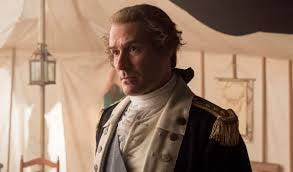Probably what deterred me as a student of history from more curiosity about George Washington was that textbooks and teachers too often portrayed him as a plaster saint rather than a real human being with feet of clay.
One cannot appreciate his greatness without first recognizing his perceived faults. His flaws bring him down to earth, to real life. My favorite portrayal of him was by Ian Kahn in the AMC series, “Turn: Washington’s Spies.”
George Washington talking to the ghost of his brother Lawrence at Valley Forge. (Lawrence died of TB in 1752.)
Did Washington carry on with his first love Mary Philipse decades later? CBS Sunday Morning: “Author and WCBS-TV anchor Mary Calvi says her research uncovered details about the first love of George Washington’s life, the heiress Mary Philipse, one of the wealthiest women in the colonies, and how their relationship may not have ended once each of them was married to others. Jim Axelrod reports on the story behind Calvi’s historical novel, “Dear George, Dear Mary,” about the first president’s first love, and with famed Washington scholar historian Richard Brookhiser about the first president’s reputation.”
Renowned presidential historian Doris Kearns Goodwin takes on George Washington in a three-part mini-series for the History Channel narrated by Jeff Daniels. “Resilience and humility and empathy” were trademarks of Washington’s character, according to Goodwin.
The worst July 4th Washington ever had, and how it led to a new nation, by Gillian Brockell Washington Post. July 4th, 1854, Washington, in his early twenties, was stuck in a humiliating surrender to the French at the poorly located Fort Necessity, PA, which started the French and Indian War, or Seven Years War, which led to the Revolutionary War. “If Washington hadn’t screwed up royally at Fort Necessity, we might not be grilling hot dogs and running around with sparklers this Fourth of July,” Brockell writes.
Franklin and Washington: The Founding Partnership by Edward J. Larson came out in 2020. Walter Isaacson in a review for The Post pointed out that they were indispensable because “each made more friends than rivals, unlike Hamilton and Jefferson and Adams. Larson laudably tries to counter the tendency of historians, especially biographers, to focus on individuals rather than teams.” He identified “three great projects that Franklin and Washington worked on together, or at least in parallel. The first was in forging a unified army out of a ragtag collection of state militias.” The second was the alliance with France. “Their third endeavor together was serving as the two lions at the Constitutional Convention in 1787.”
History for Dummies had a good summary of Washington’s character flaws:
“He wasn’t a military genius, and he lost a lot more than he won on the battlefield. In fact, his greatest military gifts were in organizing retreats and avoiding devastating losses. He had no discernible sense of humor and was a snob when it came to mixing with what he considered the lower classes.
“He also had a terrible temper. At one point, he was so angry with the lack of discipline and acts of cowardice in the American army that he unsuccessfully asked Congress to increase the allowable number of lashes for punishing soldiers from 39 to 500. Once he was so angry at a subordinate, he broke his personal rule against swearing.”
“…He wasn’t particularly handsome — his teeth were bad, and he wasn’t proud of his hippopotamus ivory and gold dentures, so he seldom smiled….
“His bosses in Congress were often indecisive, quarrelsome, and indifferent….
“…He was incredibly lucky: In one battle, Washington rode unexpectedly into a group of British soldiers, most of whom fired at him at short range. They all missed.
Several retrospectives reject the portrayals of Washington as a plaster saint.
Keep reading with a 7-day free trial
Subscribe to Slender Threads / Global Citizens / Public History to keep reading this post and get 7 days of free access to the full post archives.





